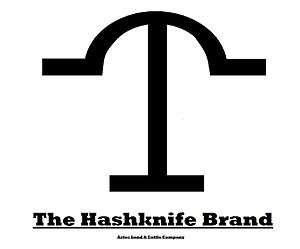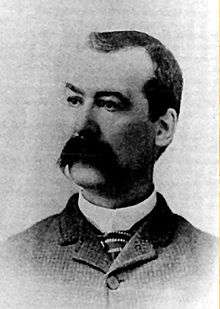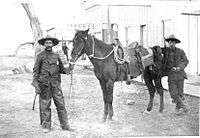Aztec Land & Cattle Company (1884–1902)
 | |
| Founded | 1884 |
|---|---|
| Founder | Edward Kinsley |
| Defunct | 1902 |
| Headquarters | Holbrook, Arizona Territory, USA |
- The historic Aztec Land & Cattle Company should not be confused with the present-day company of the same name.
The Aztec Land & Cattle Company was a cattle company that operated in northern Arizona Territory between 1884 and 1902. In its heydey, the Aztec Company was the third largest cattle company in the United States, with a range spanning over 2,000,000 acres from the border of New Mexico west to an area south of Flagstaff. The Aztec brand resembled a hashknife, a type of hook used by cooks attached to a chuck wagon. For this, the Aztec Company was also known as the Hashknife Outfit.[1]
History
Foundation
The original Aztec Land & Cattle Company was formed in Boston, Massachusetts in 1884 by Edward Kinsley and a few of his associates. Kinsley was hoping to take advantage of the recent drop in cattle prices. In the early 1880s, drought had become a serious problem to ranchers in Texas. Also, the unsettled grasslands were quickly being purchased and fenced off by "small time" farmers or ranchers. To recoup their investment, many big Texas ranchers grossly overstocked their land with the intention of selling off the cattle when the market was better. This led to overgrazing. By 1885 the beef industry had collapsed because thousands of cattle were either dead or starving to death on barren plains. The Atlantic & Pacific Railroad was also having financial difficulties so they sold 1,000,000 acres of Arizona grassland to the Aztec Company at 50¢ an acre. Aztec then bought the Continental Cattle Company of Texas to begin exporting the starving cattle to Arizona by train. The first herd consisted of 33,000 cattle and 2,200 horses. Later, another 27,000 head of cattle was sent. The original ranch headquarters was located across the Little Colorado River from Saint Joseph, but it was moved to Holbrook shortly afterward. Aztec purchased Continental's brand, the hashknife, mainly because it was difficult for cattle rustlers to alter the design and pass off as their own. Some of the original Hashknife cowboys were also hired to work the new ranch. The brand was usually put on the left side of a cow, either on the hip or on the ribcage. The blade always faced up.[1][2][3]
Grace Vandevert McNellis, the granddaughter of Bill Vandevert, who was once employed by Aztec, said the following about how she used to watch the Hashknife cowboys brand the cattle when she was a child:
| “ | I've read lots of stories about brands over the years - how some were so easy to change after being applied to the steer - by adding another brand on top! Then they would steal the cattle. Don't think the ranch ever lost any that way - at least I never heard of it. Our branding was done at the corral by the barn. I sat on the top log and watched the whole thing. There were always extra hands working and was fun. I was torn over the iron being so hot when it hit the hide of a yearling - but Dad would calm me down and say it was necessary and that it didn't hurt them but for a minute.[2] | ” |
Grace's brother, Claude, said the following:
| “ | Our brand was on the left side about midway between the front and back legs. Also, I think it was the heifer's right (could have been the left) ear that was underbitted, simply to make it easier to identify them when separating them from the steers.[2] | ” |
Lawlessness

The Hashknife men quickly developed a reputation as being the "thievinist, fightinest bunch of cowboys (sic)," particularly in Holbrook, which was only a small town of less than 300 people when the Aztec Company was formed. At first, the people of Holbrook welcomed the cowboys and the revenue that came with them, but this attitude quickly wore off. Though some of the Hashknife men were decent, others were either too rowdy and quick to pull the trigger or were engaged in criminal activity, such as rustling or armed robbery. For example, in 1886, there were twenty-six shooting deaths in Holbrook. The violence were mostly caused by an ongoing range war in the area in which people were murdered after being framed as rustlers.[1] According to Burton C. Mossman, who was one of the respectable cowboys and the ranch foreman, most of the dead were Aztec employees at one point or another. One Arizona settler wrote: "Thousands of longhorns ate the grass; riffraff and hell-hounds out of Texas ate the rancher's beef."[1]
- Sheep Wars
Almost as soon as the Aztec Company was founded, Hashknife cowboys became involved in the series of sheep wars that would occur throughout the Old West for years to come. The Pleasant Valley War, in north central Arizona, was the most deadly and long lasting of them all. It was a family feud, fought between the Tewksbury family and the Graham-Blevins faction. Though it began in 1882, the first bloodshed did not occur until a few years later, after the Tewksburys began leasing herds of sheep from the Daggs Brothers and moving them into Pleasant Valley. Aztec managed to stay out of the feud, as a whole, but some of the Hashknife cowboys had friendly relations with members of the Graham-Blevins faction and inevitably were involved in some of the shootouts, including the first engagement on August 9, 1887. Mart Blevins, the father in the Blevins family, went missing and, because he was involved in the Graham's dispute, his family assumed the Tewksburys had something to do with his disappearance. Mart's son, Hampton, formed a search party consisting of himself, a man named Tom Tucker, and three Hashknife cowboys; John Payne, Thomas Carrington and Robert Glaspie. What is certain about the gunfight is that the search party arrived at the Middleton Ranch, which was owned by a family friend of the Tewksburys, and requested dinner and a place to sleep for the night. According to differing accounts, the search party was refused and then somebody started shooting. There were six men inside the Middleton ranch house when the skirmish erupted, three of whom were Tewksbury men. None of the defenders were hurt, but both Hampton and Payne were killed and Tucker and Glaspie were wounded. Carrington managed to escape "with his clothing perforated by a bullet," though he was unharmed otherwise. The feud quickly escalated from there. Additional shootouts and killings continued until 1892, when the last man in the Graham family was killed.[4][5][6][7]
There were other conflicts as well. Because they excluded everyone else from using over 2,000,000 acres of range land that was previously open, the Aztec Company placed a terrible strain on the "small time" ranchers and farmers in the area. After shepherds began moving their flocks of sheep into northern Arizona, the cowboys established deadlines and began attacking anyone who crossed them. On more than one occasion, Hashknife cowboys herded thousands of sheep into the Little Colorado River, where they drowned, or used horses to ride into a herd and scatter it.[8]
- Canyon Diablo Train Robbery
Perhaps the most famous incident of lawlessness committed by Aztec employees was the Canyon Diablo Train Robbery. On the morning of March 20, 1889, near the town of Canyon Diablo four masked cowboys stopped a train belonging to the Santa Fe Railway[It was owned by the Atlantic and Pacific Railway not the Santa Fe] and stole about $1,500 before riding north. A reward of $500 was offered for any information leading to the capture of the bandits, and the sheriff of Yavapai County was informed. Sheriff William "Buckey" O'Neill organized a posse with four other men and began pursuing the bandits, who were easy to track because of footprints left in snow by the horses. Several days later, the posse made contact with them just across the border in Utah. A running battle ensued for the next five days, at the end of which the posse trapped the cowboys inside Wahweap Canyon, near Cannonville, and forced them to surrender. Though nobody was killed during the shootout, Sheriff O'Neill became famous nationwide. On April 16, Sheriff O'Neill described the event to a reporter for Tucson's Star newspaper. O'Neill called the bandits the "worst desperadoes that ever operated in this western country," and said their names were Tony Quince, William "Billy" Steiner, or Sterin, Charles Clark and James Smith. In reality, Tony Quince was actually John Halford and Charles Clark was D.M. Harvick. Smith denied his involvement in the robbery, saying that he met up with the other three at the Black Falls Crossing on the Little Colorado. Smith also said he knew both Harvick and Halford from cowboying, but was on his way to Hamilton, Nevada, to become a miner, when the bandits asked him to guide them to Cannonville.[9][10]
Sheriff O'Neill told the Star that Smith escaped from his custody during the return to Tucson. Wearing shackles, at about 1:00 am in the morning, Smith managed to jump out the window of a train as it headed full speed up Raton Pass, Colorado. He survived unhurt and later made his way down to Texas where he was captured and sent back to Arizona. Even though Halford, Harvick and Steiner claimed that Smith was not guilty, the judge presiding over the case refused to hear Smith's testimony. Each man was given a 25-year sentence at Yuma Territorial Prison, but Smith received an extra five years as punishment for his escape. In Yuma, Smith continued to proclaim his innocence and in 1893 he applied for a pardon. Among the application was a statement from Halford, Harvick and Steiner saying that Smith was really innocent. He had also grown somewhat unhealthy in prison. According to the prison physician, Dr. Cotter, Smith suffered from several hemorrhages and a lung infection. His presence spread germs to other inmates. The territorial governor, L. C. Hughes, was not convinced, though, and he decided to personally interview each man before making his verdict. Again, all of the three self-admitted robbers said that Smith was innocent, so Hughes granted him his pardon and he was released on August 12, 1893. The rest of the cowboys remained in jail, but, according to local lore, Steiner was later released and joined the Rough Riders in 1898. Having enlisted under a false name, Steiner is said to have died in the Battle of San Juan Hill while serving under Buckey O'Neill, who also joined the Rough Riders and died during the battle.[9][11]
Collapse

The Aztec Company collapsed in 1902 after only eighteen years of operation. Just as in Texas, drought and overgrazing destroyed the land and a large amount of cattle starved to death. Because of the drought and the cattle eating everything, the yearly monsoons washed away the topsoil and turned the once fertile grasslands into a desert striped with ravines. The trouble began in 1894, by which time, much of the Aztec range was already nearly void of vegetation. Over the next few years, the company lost a lot of its income so the proprietors began selling off both the cattle and the land to pay off their debt. By 1902 there was only one employee left, a house keeper who took care of the ranch headquarters and the few remaining horses. That same year, the company and the Hashknife brand were sold to the Babbitt Brothers of Flagstaff, Arizona. The brand continued to be used until around 1910. Ultimately, the Aztec Company's greatest legacy was not its size or the lawlessness of its employees, but rather its impact on the local environment. Much of the former range land remains scarred to this day, particularly around the Little Colorado River.[6][8][12][13]
One Arizona pioneer wrote the following about Aztec's impact on the local environment:
| “ | When we came to Arizona in 1876, the hills and plains were covered with high grass and the country was not cut up with ravines and gullies as it is now. This has been brought about through overstocking the ranges. On the Little Colorado we could cut hay for miles and miles in every direction. The Aztec Cattle Company brought tens of thousands of cattle into the country, claimed every other section, overstocked the range and fed out all the grass. Then the water, not being held back, followed the cattletrails and cut the country up. Later tens of thousands of cattle died because of drought and lack of feed and disease. The river banks were covered with dead carcasses.[12] | ” |
A present-day Aztec Land & Cattle Company, Ltd. was formed in 2007 and has its headquarters in Phoenix.[14][15]
See also
References
- 1 2 3 4 "Arizona Legends: The Aztec Cattle Company & the Hashknife Outfit". Retrieved June 27, 2012.
- 1 2 3 "Vandevert Ranch: The Hashknife Brand". Retrieved June 27, 2012.
- ↑ "Arizona Legends: Pleasant Valley War". Retrieved June 27, 2012.
- ↑ Hanchett, Leland J. Jr. (1994). Arizona's Graham-Tewkesbury Feud. Phoenix, Arizona: Pine Rim Publishing. ISBN 0-9637785-3-6.
- 1 2 Abruzzi, William S. (1993). Dam That River!: Ecology and Mormon Settlement in the Little Colorado River Basin. University Press of America. ISBN 978-0-8191-9126-7.
- ↑ Rosa, Joseph G. (1995). Age of the Gunfighter: Men and Weapons on the Frontier, 1840-1900. University of Oklahoma Press. ISBN 978-0-8061-2761-3.
- 1 2 "The Hashknife Outfit". Retrieved June 27, 2012.
- 1 2 "Canyon Diablo Train Robbery: Tombstone Epitaph Newspaper Vol. CXXII No. 1.". Retrieved June 27, 2012.
- ↑ "Ghost Towns of the Railroad: Railroad Ghosts of Canyon Diablo". Retrieved June 27, 2012.
- ↑ "O'Neill: Captain William Owen "Buckey" O'Neill (1860 - 1898)". Norm Tessman. Retrieved June 27, 2012.
- 1 2 "The social and ecological consequences of early cattle ranching in the Little Colorado River Basin, Arizona". William S. Abruzzi. Archived from the original on March 2, 2012. Retrieved June 27, 2012.
- ↑ Sheridan, Thomas E. (1995). Arizona: A History. University of Arizona Press. ISBN 978-0-8165-1515-8.
- ↑ "Aztec Land and Cattle Company, Limited". Retrieved June 27, 2012.
- ↑ "Aztec Land & Cattle CO (Aztec Land & Cattle Company) - Phoenix, Arizona (AZ)". Retrieved June 27, 2012.
Further reading
- Herman, Daniel J. (2010), Hell on the Range: A Story of Honor, Conscience, and the American West, New Haven, Connecticut: Yale University Press, ISBN 9780300137361, OCLC 601348221